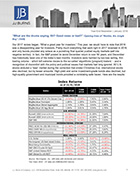“In engineering if you do not know what you are doing you should not be doing it.” Richard Hamming
Our financial engineers, also referred to as central bankers, helped Investors enjoy another strong quarter in Q2. Fixed-income investors enjoyed strong municipal and credit returns, and U.S. equity owners benefitted from a strong Q-1 earnings season and a still-growing economy. Foreign-stock investors had much to cheer as well, as growth results and expectations have been improving in both developed and emerging economies, leading to better earnings.
It’s clear that the U.S. is in the later stage of its post-crisis recovery. Despite worries about President Trump’s policy direction, expectations are for a long expansion with little threat of recession on the horizon. This is also the time when markets tend to get ‘exuberant,’ and our ‘engineers’ must now look to the future rather than dwell on past success. Here’s a summary of recent market results:

“We cannot solve our problems with the same thinking we used when we created them.” Albert Einstein
Here’s a brief review of some interesting data and trends we’re following:
Global growth and earnings: Slowly but surely, global earnings are moving in sync, as shown below. IMF projections of global growth, though not as high as in past years, are trending slightly up. Regions outside the U.S., which were late to institute Financial Crisis palliatives similar to those managed by the U.S. government and the Fed, are finally showing their own ‘green shoots.’ Structural banking and employment issues were worse in Europe than in the U.S., but the ECB’s easing program and stimulative growth policies have spurred earnings and GDP growth. The U.S. may enjoy an earnings tailwind from a weakening U.S. dollar as the overseas rebound continues.

International stocks: The long-awaited economic rebound in ex-U.S. regions has promoted strong returns in developed- and emerging-markets stocks. While we think U.S. stock valuations are stretched, they still have room to run although they are more fully valued than overseas stocks. U.S. investors with foreign-stock exposure are experiencing the benefits of positive earnings, regional growth, a falling dollar and improving valuations. We believe the decline in rolling one-year correlations between U.S. and foreign stocks should promote positive portfolio effects as foreign markets continue to run.

Allocation decisions: Despite the long-lived bull market that started in 2009, investors have pushed a tremendous amount of net cash into bond ETFS and funds since the Global Financial Crisis. This has had several effects, including: (1) a shifting of risk from stock volatility to interest-rate volatility; (2) an increase in accumulation risk, i.e. the risk that portfolios won’t grow enough for retirement; and (3) timing risk, as investors may pull funds from bonds to buy stocks near this bull’s peak. We believe in long-term, diversified portfolios to avoid this poor decision-making based on market timing, but the shift of assets from bonds to stocks should add support to the equity market.
“Successful engineering is all about understanding how things break or fail.” Henry Petroski
These encouraging global equity and GDP results weren’t accomplished in a vacuum. Unprecedented central bank (CB) intervention in the form of low interest rates and bond purchases have reflated asset markets and repaired household balance sheets. These actions have assuaged investors, but have come at a cost, which is reflected in the graph below. This shows the balance–sheet growth of central banks to almost $20 trillion over 10 years. Charles Gave of Gavekal Research recently noted that, in the U.S., the money ‘created’ by the Fed simply ‘stay[ed] in the financial markets’ and did not flow in to the real economy. Ending this feat of financial engineering without causing a severe recession will be ‘the most extraordinary exercise in fine-tuning they [the Fed] have ever attempted.’ This same challenge faces all central banks, and, like building a bridge, requires precise estimations of stress and an appreciation of the effects of time on their decisions.

We think global equity markets and economies are finally in sync and have room to expand. Volatility and financial-market profit-taking will trend higher, however, and bonds will be more volatile than in the recent past. We advise clients to review their financial plans and portfolio allocations to prepare for the inevitable market pullbacks that lie ahead.
As always, we welcome your comments and questions.
—Your Wealth Management Team at JJ Burns & Company
Download Market Commentary
Disclosure: J.J. Burns & Company, LLC is a registered investment adviser with the U.S. Securities & Exchange Commission and maintains notice filings with the States of New York, Florida Pennsylvania, New Jersey, Connecticut, Georgia, Illinois, North Carolina, and California. J.J. Burns & Company, LLC only transacts business in states where it is properly registered, or excluded or exempted from registration. Follow-up and individualized responses to persons that involves either the effecting or attempting to effect transactions in securities, or the rendering of personalized investment advice for compensation, as the case may be, will not be made absent compliance with state investment adviser and investment adviser representative registration requirements, or an applicable exemption or exclusion.
All investing involves risk, including the potential for loss of principal. There is no guarantee that any investment plan or strategy will be successful.
The foregoing content reflects the opinions of J.J. Burns & Company, LLC and is subject to change at any time without notice. Content provided herein is for informational purposes only and should not be used or construed as investment advice or a recommendation regarding the purchase or sale of any security. There is no guarantee that the statements, opinions or forecasts provided herein will prove to be correct.
Past performance may not be indicative of future results. Indices are not available for direct investment. Any investor who attempts to mimic the performance of an index would incur fees and expenses which would reduce returns.
Securities investing involves risk, including the potential for loss of principal. There is no assurance that any investment plan or strategy will be successful.



